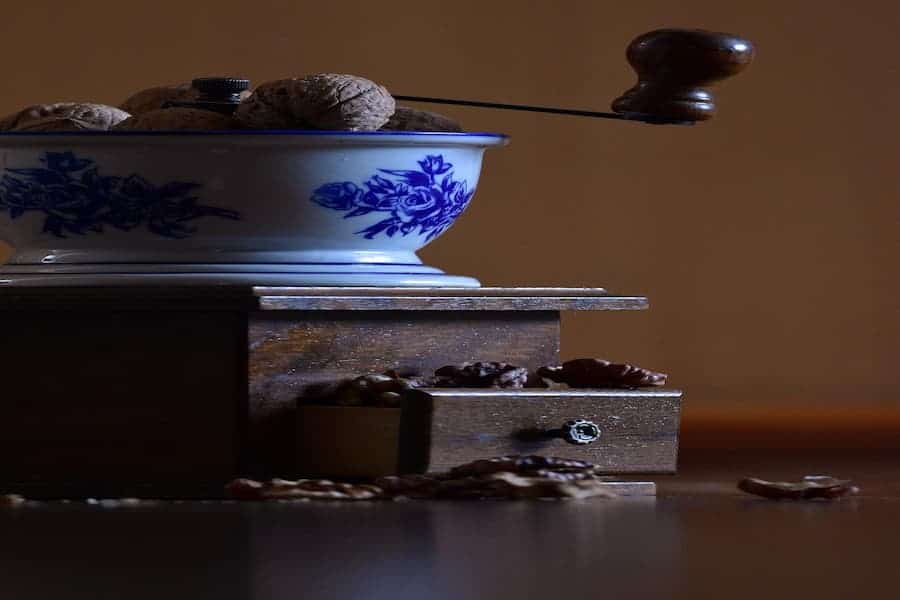As an Amazon Associate we earn from qualifying purchases.
Chopping nuts by hand can be a difficult task, and that’s why I have nut choppers. These little devices allow you to chop nuts easily and quickly. Both manual and electric nut choppers are available in the market, and they make the process of chopping nuts a breeze.
It’s important to take care of your nut chopper so that it can serve you for years to come. The best way to maintain your appliance is to clean it regularly, especially the blades, to keep chopping nuts efficiently.
So, let’s discuss a step-by-step guide that will help you learn how to clean a nut chopper’s blades easily.

Quick Navigation
How to Clean the Blades of a Nut Chopper
The cleaning instructions of nut chopper blades vary from model to model. I recommend reading the device’s user manual to understand the cleaning instructions properly.
Step 1: Disassemble the Nut Chopper
The first step is to disassemble your nut chopper by taking each piece apart. It’ll allow you to clean blades, and you’ll also be able to wash other parts properly. Similar to how you clean an electric skillet, if you have an electric nut chopper, ensure it’s not attached to a wall outlet and keep its electrical components away from water.
Be extra careful while disassembling blades. They’re extremely sharp and can cut your fingers easily. You can wear a pair of leather gloves to minimize getting hurt.
Step 2: Use a Dry Cloth
Once you have taken apart each component, use a dry cloth to rinse off the large nut particles from the blades. You can use the same technique to clean other parts of the chopper. It’ll allow you to see small particles stuck between crevices.
Step 3: Use a Dish Soap and Lukewarm Water

Use a mixture of dish soap and lukewarm water to start cleaning your nut chopper’s blades. Use a sponge to clean the flat surfaces and switch to a nylon brush to eliminate the particles stuck between crevices. Use the same technique to clean the other parts of the device.
Unlike how a meat grinder is submerged for proper cleaning, I recommend you not submerge any component of an electric nut chopper in water, except the blades. Instead, use a damp cloth to clean them properly.
Step 4: Dry the Nut Chopper’s Blades
Once you have cleaned the blades and other components, the next step is to dry them thoroughly. Performing this step is critical as it’ll increase the longevity of your nut chopper.
Use a soft dry cloth for drying purposes and let all the components sit on your kitchen countertop for 15 to 20 minutes. It’ll allow the blades and other parts to eliminate moisture content between crevices that can’t be dried with a cloth.
Step 5: Reassemble the Nut Chopper
The final step is to reassemble your nut chopper with cleaned blades. Make sure that you follow the same steps that you used to disassemble the device. Secure each part properly to use the device seamlessly to chop nuts again.
Tips to Clean the Blades of a Nut Chopper
Keep the following tips in mind to clean and maintain your nut chopper.
- You should clean the blades of your nut chopper regularly, ideally after each use. The moisture and oil content in nuts can lubricate the blades, and if you don’t clean them regularly, they won’t stay sharp for an extended period.
- Nut choppers are easy to clean, but the instructions can vary from model to model. Make sure that you read the user manual carefully to find out the right procedure to disassemble a particular unit you have.
- Never place your nut chopper in a dishwasher without confirming it’s dishwater-friendly.
- Avoid using alkaline cleansers to clean your device because these solutions contain elements that can lead to pitting. Using such cleansers multiple times can also cause permanent damage, and you’ll need to buy a new nut chopper. Use a mild detergent or a mixture of water and soap.
- Don’t try to clean your device with water without disassembling it, even if it is water-friendly.
- Dry all the parts of your device, especially blades, immediately after cleaning them. Never let water sit on blades if they’re made of metal.
- You can also use a fine honing stone to sharpen the blades if you feel they have become dull, but never file them as it can alter the angle of the blades. If you don’t know the proper method to sharpen blades, I recommend sending them to your unit’s manufacturer for proper restoration.
- Apply mineral oil to the moving parts to lubricate them. Don’t use cooking oil for this purpose, as it can easily become sticky.
Frequently Asked Questions
The following are some commonly asked questions on how to clean the blades of a nut chopper.
What Do You Do if Nut Chopper Blades Smell Bad?
If you notice your nut chopper blades are smelly, mix water and baking soda and place the blades in that mixture for 10 to 15 minutes. The baking soda will absorb bad odors to resolve the problem.
How Long Does a Nut Chopper Last?
The lifespan of a nut chopper can vary from model to model, and the frequency of use and cleaning also matter. Generally, a high-quality nut chopper can last for up to 10 years if you take care of it by cleaning it regularly.
Final Words
Cleaning the blades of a nut chopper is an easy task. Disassembling your device is the only tricky part, and you can figure that out by reading the user manual of the product you have. I hope this guide will help you understand the proper method to clean your nut chopper to maximize its lifespan.
